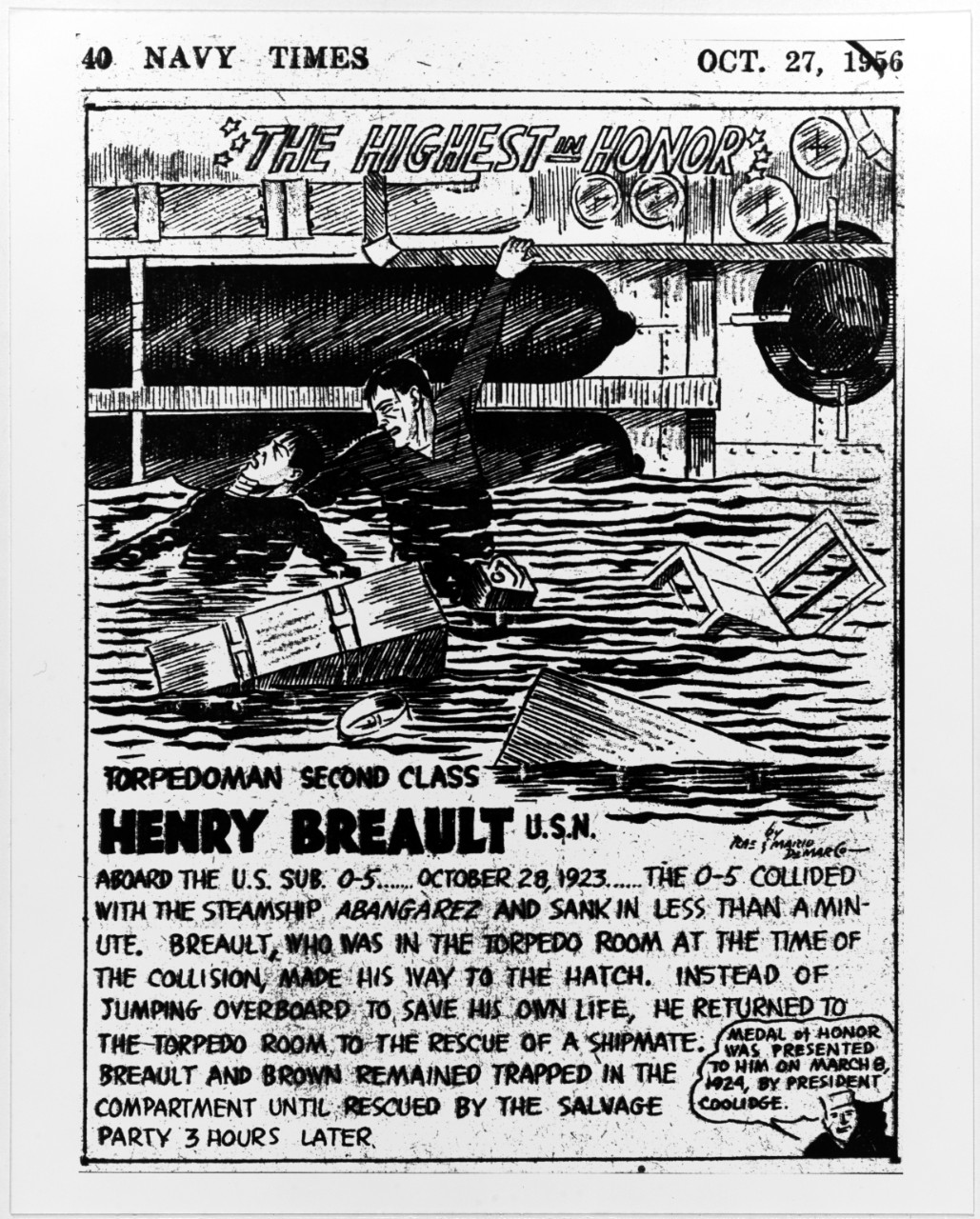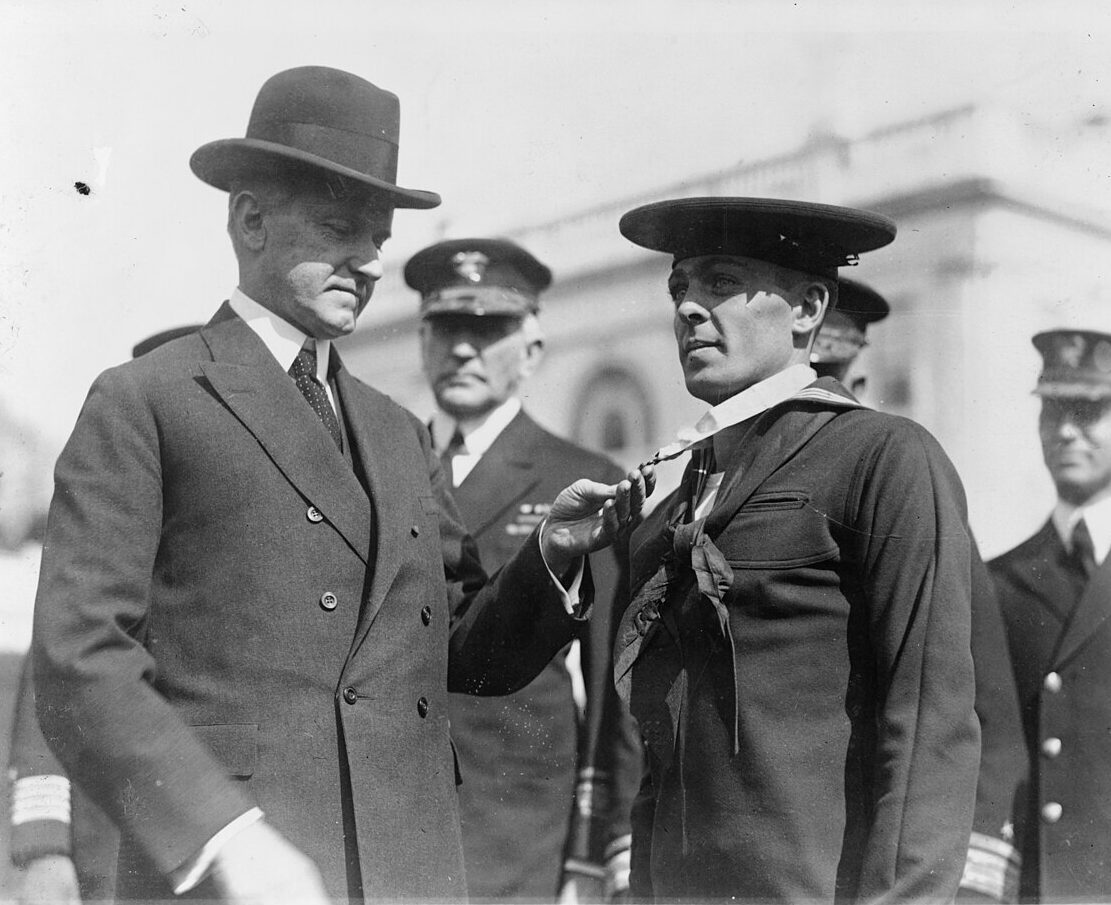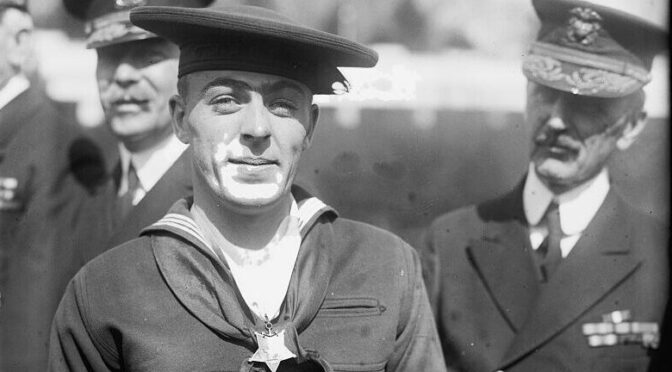By Ryan C. Walker
Introduction
On October 28, 1923, as USS O-5 was beginning its transit through the Panama Canal to participate in fleet exercises, it collided with the United Fruit Company’s Abangarez, sinking in less than a minute.¹ Most of the crew managed to escape, but one sailor made a fateful decision that saved the life of his shipmate. That sailor’s Medal of Honor Citation reads:
“For heroism and devotion to duty while serving on board the U.S. submarine O-5 at the time of the sinking of that vessel. On the morning of 28 October 1923, the O-5 collided with the steamship Abangarez and sank in less than a minute. When the collision occurred, Breault was in the torpedo room. Upon reaching the hatch, he saw that the boat was rapidly sinking. Instead of jumping overboard to save his own life, he returned to the torpedo room to the rescue of a shipmate who he knew was trapped in the boat, closing the torpedo room hatch on himself. Breault and Brown remained trapped in this compartment until rescued by the salvage party 31 hours later.”²
Eight submariners have been awarded the Medal of Honor while serving aboard submarines, but only one was an enlisted man. He happened to be the first as well: Torpedoman’s Mate First Class (TM1, he received the award as a TM2) Henry Breault.
After receiving his award, Breault continued to serve despite failing health, only ending his service when he passed on to Eternal Patrol due to congestive heart failure two days before the attack on Pearl Harbor – December 5, 1941. He rests in St. Mary’s Cemetery in Putnam, CT, but lives on as a submariner folk hero. There has never been a naval vessel named to honor Breault. Naming a Virginia-Class submarine after Breault would not only honor his extraordinary courage but serve as a lasting reminder of the values that continue to guide submariners today.

The Rescue
The Canal community’s efforts to rescue USS O-5 are described by Julius Grigore Jr. in two articles published in the Military Engineer (1969) and Proceedings (1972). They stand as the comprehensive accounts of the collision and rescue, though some inaccuracies remain, such as the number of attempts to raise the vessel and reported date of Breault’s Medal of Honor award ceremony (Grigore reported April 4, 1924, likely the date Breault returned to Coco Solo).³
According to Grigore’s account, when reports of the collision and sinking arrived, divers mobilized to locate O-5 and determine if there were any survivors. Through knocks against the hull, Breault and Brown were able to signal their location in the torpedo room. While they were thankfully in shallow water, once they had made contact, their active role ended; they had to wait for 31 hours with no food or water and only a flashlight as the Panama Canal community made efforts to rescue them.
At that time, no formal procedure existed for rescue from a disabled submarine resting seven fathoms deep other than to escape via the torpedo tubes, an evolution which had only been attempted with divers in controlled environments close to the surface.4 Further, due to interlocks, one individual would have had to remain behind to open the torpedo tube. Assessing their options, Breault and Brown made the fateful decision that either both of them or neither of them would escape their refuge.
Commander, Submarine Base Coco Solo, Amon Bronson assumed command of the rescue operation and requested the heaviest lift capacity crane barges, Hercules and Ajax from the Panama Canal. Both crane barges were on the other end of the canal and in a twist of fate, unable to immediately respond due to a landslide at the Gaillard Cut that occurred at nearly the same time as the collision: the vessels needed to wait for the rubble to be cleared, and the first rescue attempt began 13 hours after the collision.
Upon his arrival, civilian diver Sheppard Shreaves would relieve USN divers and spend nearly 24 hours clearing debris and mud, and attaching the lifting hook to the disabled O-5. He would receive the Congressional Gold Lifesaving Medal and a gold watch gifted by submariners for his efforts. Three lift attempts failed, but on the fourth attempt, the O-5 was raised to the surface and Breault and Brown were able to exit via the torpedo room hatch.5

While Grigore asserts that Brown fainted from prostration upon rescue, it is more likely that it was actually Breault, who was inflicted with Caisson Disease, colloquially known as the bends. As a result, the primary account of the rescue did not belong to Breault, but to Brown. Brown “seemed no worse for wear” and he was in a lucid enough state to retell their story.6 Brown states that he was resting before his watch when he felt the crash from the Abangarez. Alerted by Breault, “We both went into the torpedo room, closing the door behind us. The boat sank in thirty seconds, settling in forty feet of water at an angle of 70 degrees to starboard.” Finding themselves trapped in a compartment with 12 inches of water, holding fast to a ladder with only a flashlight for illumination, Brown recalled that “the first hour was the hardest”:
“Breault and I separated to pound on each of the boat’s sides. In this way, the rescuers would know that were two of us. Breault played a kind of tune with his hammer, indicating to the diver that we were in good shape and cheerful. Neither of us knew Morse Code. We had no food or water, and only a flashlight. We were confident we could stay alive for forty-eight hours.”
The pair’s patience was rewarded once they heard the activity of the Panama Canal community working to affect their rescue.7 While being treated, Breault estimated that the compartment pressure was between 25 and 50 pounds but the medical professionals treating Breault disputed these numbers, deciding they were unlikely, but agreed that the two men had been subjected to high pressure in the compartment for an extended period.8
When asked why he stayed on-board instead of jumping for safety, Breault stated simply, ‘I wanted to stay and help, if I could.”9 Surprisingly, this appears to be the extent of what Breault shared after his rescue as no official statements were recorded in his Official Military Personnel File on the subject and only one letter was identified as being from him. The letter is available today thanks to its publication in the New York Times:
“Just a line to let you know that I am still alive. You have no doubt read about the sinking of the submarine. We were down there for hours and had no food. There was water in the lead tanks, but we did not dare to use it because it had been there for months and we were afraid of lead poisoning. I sure was a sick boy but am well now. I have been out helping to raise the submarine. She is all right except the central control room where she was struck. The craft will soon be in condition again. But some of the crew will never go down in a submarine again. Fortunately it did not bother me at all.”10
At the time, the story was well reported, but public sentiment and interest was best captured by Omaha’s Sunday Bee on November 4, 1923:
“Simple enough, when told in words, but tremendously important when calmly viewed. It is the real glory of the service, for it was not done in presence of the embattled foeman, but as a routine act when danger and death threatened in an unexpected form. Henry Breault’s name goes down with other heroes who have brought honor to themselves and pride to Americans.”11

Remembering Breault a Century Later
Barring reports following the event and Grigore’s research, Breault remained largely forgotten until the early 1990s, when several submariners uncovered research conducted by the Aspinock Historical Society in Putnam, CT, and the Submarine Force Library and Museum (SFLM) in Groton, CT. The SFLM did not have an exhibit for Breault in its Medal of Honor section, and he was included only after Curator Stephen Finnegan discovered Grigore’s two articles in the 1990s.12
Jim Christley built on this research and introduced it to the submarine force, leading to renewed interest by the USN that began to culminate by the turn of the millennium. A new pier was named for Breault in Pearl Harbor, HI, on June 18, 1999 and on May 19, 2001, a memorial was dedicated at Naval Station New London’s Wilkinson Hall in Groton, CT.13 Breault’s hometown of Putnam, CT also dedicated a footbridge in his memory on 11 November 2003, ensuring Breault would never be forgotten.14
Over time, these efforts have contributed to Breault’s growing status as submarine folk hero. On March 8, 2024, the centennial anniversary of Breault’s award, a Basic Enlisted Submarine School class named in Breault’s honor graduated on that same day, where he was remembered as 96 aspiring submariners moved on to their next commands, with guest speakers including representatives from CT’s federal legislature and RADM (ret.) Arnie Lotring, who gave a speech honoring Breault. On March 15, 2024, the Honorable Vermont State Representative Michael Morgan invited local submariners to read House Concurrent Resolution 167 on the Vermont House floor recognizing Breault and the submarine service.15 The final tribute to offer as his this centennial year passes, could only be to name a Virginia-Class submarine the USS Henry Breault.
Why the USS Henry Breault
Virginia-class submarines were intended to be named after states, a legacy carried on from the Ohio-class. Recently, deviations from this tradition have come under scrutiny as recent vessel names have transitioned from states to fish (Tang, Wahoo, Barb, and Silversides), cities (San Francisco and Miami), and even regions (Long Island). As a Congressional Research Report noted in 2024:
“Until 2020, Virginia (SSN-774) class attack submarines were named largely for states, but the most recent eight have been named for four earlier U.S. Navy attack submarines, a former Secretary of the Navy, an island, and two cities, suggesting that there is no longer a clear naming rule for the class”
As there is no longer a hard rule that guides the naming convention, it is an ideal time to ask, why not include a Medal of Honor recipient? John Warner, Hyman G. Rickover, and John H. Dalton either have Virginia-Class submarines named after them or will. Before that, Jimmy Carter, Mendel Rivers, Henry M. Jackson, the ’41 for Freedom’ and so many other dignitaries have been honored as submarine namesakes. Breault’s impact on the submariner community alone, notwithstanding his heroism, warrants his consideration – naming a boat in his honor will aid in recruitment and retention efforts, connect communities (old friends and new) to the submarine force, and remind sailors of their heritage.
USS Henry Breault will Support Recruitment and Retention
In an era where the USN is struggling with recruitment and retention, the publicity generated by naming a submarine after an enlisted Medal of Honor recipient would be significant. It would demonstrate that the USN understands the sacrifices that the enlisted corps has made and will to protect freedom and democracy around the world. The USN’s recruitment goal in FY24 was 40,600 new recruits, an increase from the previous fiscal year “despite two years of missing its aim for new sailors,” for a total of 40,978 new active-duty recruits enlisted.16 This is good news, but those recruits do not immediately address unfilled at-sea billets, which in May 2024 number nearly 18,000.17
Naming a submarine in honor of the only enlisted submariner to receive the Medal of Honor would emphasize the contributions of the enlisted corps of the submarine force and potentially inspire more men and women to enlist. The publicity generated would positively influence public perceptions of the role of enlisted submariners and similarly enhance the prestige of the undersea warfare community as the naming of a Ford-class aircraft carrier for Petty Officer Third-Class Doris Miller has achieved for the aviation and surface communities.

“Fish Don’t Vote”
Allegorically, Hyman G. Rickover once shared at a dinner party that submarines were named after locations rather than fish because “fish don’t vote.”18 This has often driven their naming to be connected to locations, but deviating from this tradition would in this case serve to amplify the vessel’s connection to many communities across the nation, as Breault has significant local ties in several states. He was born in Putnam, CT, but moved to White Plains, NY in his childhood. He enlisted from Vermont, offering an address in Grand Isle, VT. When he was active-duty, Breault spent time in San Diego, Los Angeles, and San Francisco in CA, and referred to Marysville, WA, as “home” in official paperwork. When he passed, he was stationed in Newport, RI, where he also attended recruit training and “A” school. Breault’s service emphasizes the contribution these states have made to the success of the submarine force and if connected, would allow several major regions in the US to benefit from the namesake. It would remind many that building submarines is a nation-wide effort that we must support and maintain.
The Essential Duty of the Submariner: Ship, Shipmate, Self
When I was active-duty, the first man that came to mind when I heard the line in the Sailor’s Creed, “I represent the fighting spirit of the Navy and those who have gone before me to defend freedom and democracy around the world.”, was Henry Breault. Breault received the Medal of Honor for attempting to save the ship and when he realized nothing more could be done, doing everything he could to save a shipmate. He saved the life of at least one of his shipmates (Lawrence Brown), and likely purchased time for another (Charles Butler) to escape. Breault’s willingness to “cast all personal safety aside” as described by his commanding officer, Harrison Avery, represents the expectation of every enlisted submariner today.19
The USN must take every opportunity it can to reconnect its sailors and the American public to its mission and values, and a USS Henry Breault would certainly become such an embodiment. Breault represents not only the fighting spirit of the navy, but the trust we place in our shipmates. Even during routine evolutions or transits, we could be called to perform unbelievable heroic tasks: because we trust all we serve alongside.

Conclusion
USS Henry Breault has the potential to be a unifying force for the USN and the nation, as recognized by the nearly 1,600 people who signed the petition to name a submarine in his honor, and local leaders in numerous communities such as Putnam, CT have signaled their intent to support the submarine. History was made when the USS Doris Miller, was announced, named in honor of Doris, “Dorie” Miller, and in Breault, the submariner community finds an opportunity to name a submarine in honor of one of its own.
The USS Henry Breault would connect sailors to their heritage, recognize the efforts of several states to the submarine force, and aid in recruiting and retention efforts. In a time when sailors are so needed, let us remind them that we remember why.
Ryan C Walker served as a submariner in the USN from 2014-2019. After being honorably discharged, he worked in the defense industry while attending Southern New Hampshire University and University of Portsmouth, receiving in the former his BA in History and in the latter his MA in Naval History. Ryan is a PhD candidate at Portsmouth and has published several articles and chapters in edited collections on American submariners, American Naval-Capital towns, and British Private-Men-of-War. His first book, The Silent Service’s First Hero, was released this year and is a microhistorical investigation into the life and times of Henry Breault.
Endnotes
[1]. Julius Grigore, Jr., ‘The Luck of the Submarine O-5’, The Military Engineer, 61, No. 402
[2]. Congressional Medal of Honor, “Henry Breault,” https://www.cmohs.org/recipients/henry-breault.
[3]. Julius Grigore, Jr., ‘The Luck of the Submarine O-5’, The Military Engineer, 61, No. 402

